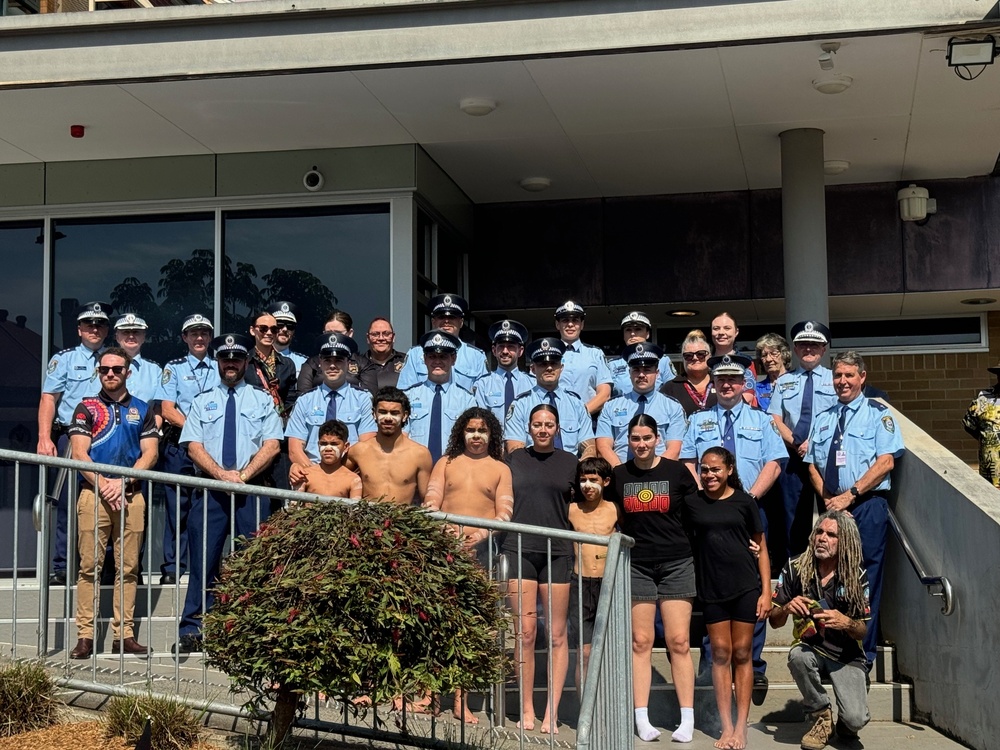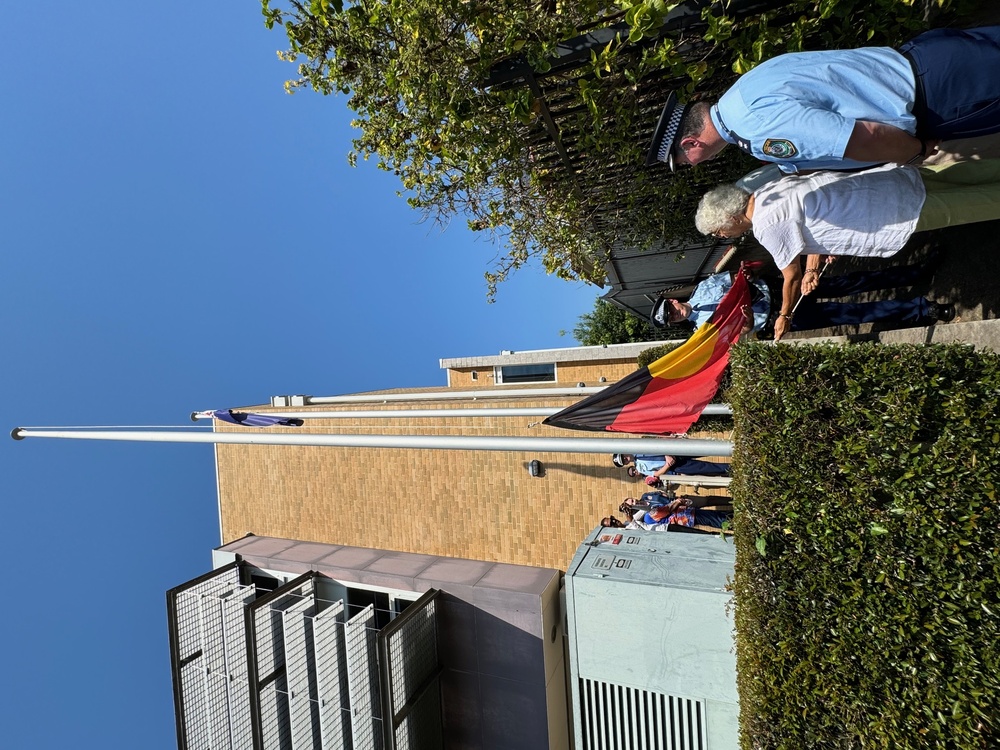Lismore Police Station to fly Aboriginal flag daily in region first
Simon Mumford
27 August 2024, 8:00 PM
 Aunty Julia Padden and Aunty Sandra Bolt hoist the Aboriginal flag watched on by Richmond Police District Superintendent Scott Tanner
Aunty Julia Padden and Aunty Sandra Bolt hoist the Aboriginal flag watched on by Richmond Police District Superintendent Scott TannerIn a first for Lismore, the Lismore Police Station will fly the Aboriginal flag alongside the Australian flag daily. Previously, it had only been flown on specific days or weeks, such as NAIDOC or Sorry Day.
At a ceremony held yesterday, Aunty Julia Padden and Aunty Sandra Bolt hoisted the Aboriginal flag with other community elders in attendance, Mayor Steve Krieg and members of the Richmond Police District.
"It signifies the relationship that we have with our First Nations community, the respect that we have for that relationship, and hopefully can be a link for people that need to come to the police station to see that we do have that respect and that acknowledgement for our First Nations community," Superintendent Richmond Police District Scott Tanner told the Lismore App.
Following a smoking ceremony by Uncle Gilbert and an Acknowledgement To Country by Uncle Mick and Mindy Woods, Aunty Thelma and Koori Mail CEO Naomi Moran delivered speeches about the relationship between police and the aboriginal community.

(A group shot of officers from Richmond Police District and dancers from Richmond River High Campus who performed traditional aboriginal dances in the lead up to the raising of the flag)
Aunty Thelma told stories about police officers from the past who connected with the community by helping illiterate Indigenous men get their truck licenses. When there was a curfew on the youth in town, "rich white ladies who lived on Bridge Street used to look out their doors and say "go on you kids, get home". If a flood were coming, police would personally go and communicate the message and Aunty Thelma's daughter was wearing a policeman's hat when they were walking around the CBD block, laughing with the police.
"I've always taught the children in my class (Aunty Thelma was a teacher) to respect the police, because they're there when you really need help, and the uniform is a sign of that. Alright, we might have all had encounters, but I don't think I have ever had any encounter. So, teaching the children to be respectful, to go up and say hello. It was nice when police used to walk around the Lismore city block because we'd all talk, and we all knew everybody."
Uncle Gilbert lives in Nimbin, and told the audience he has been talking to the local Nimbin police about trying to get a plan together to work with Aboriginal youth.
"Because our youth, they're going on the wrong path, and we don't want that. We want to work with you guys. So we can set up, set up like a PCYC, where we can bring our young ones, who are scared because of the uniform. When they see you guys with a uniform on, they get intimidated. They get anxiety attacks, and we want to take that out of our young people so that we can work with you guys and we can bring them here. So good to know you guys, and we all work together and support each other."
Koori Mail CEO Naomi Moran spoke about how important trust and communication is between the police and Indigenous people.
"It's about connection. It's about being vulnerable in what you represent with your uniform but also about our communities being vulnerable, and what those expectations are and what it means to serve and protect us.
"We're just humans, and we need to be comfortable around each other in order to get the job done and do the work."

(Aunty Julia Padden and Aunty Sandra Bolt hoist the Aboriginal flag watched on by Richmond Police District Superintendent Scott Tanner)
The points mentioned above were not lost on Superintendent Scott Tanner.
"We need to get back to that grassroots connection with the community because of a variety of reasons, too many to list, we've lost that direct communication, that direct link.
"I had about twelve (12) of my Aboriginal police officers and staff that were here today who are identified by the two flags, the New South Wales Police flag and the Aboriginal flag, which they wear on their uniform. What I want to do is encourage people in the community to know what that means and that those officers wearing that badge identify as Aboriginal people.
"I think that's a real critical link in getting back to some of that real close communication and partnerships. The second thing is that days like today, where we do see the elders come along and share their experiences, resets you again to go, you know what? If it's that simple, then why aren't we doing it. To hear from the elders that this is how it used to be. Well, there's no reason we can't do it again."
"Historically, we know the relationship wasn't good, from colonial days through to more recent times. But when you take the time out just to listen to your elders and to listen to the community, it comes down to that basic human need of just having connection and having relationships. And I think Naomi Moran sort of captured that the best, at the end of the day. We're all humans, and we're all people, and we want that connection, so that's what I aim to do."
One of the great divides is between youth and the police, how do you intend to bridge that gap?
"Definitely. We already do a lot. We've got a designated Aboriginal Youth Team, which is our youth officers and our aclose that work every day with youth. We're running programs everywhere from Jubullum to Coraki to Ballina to Lismore and Goonellabah. There's not a day going by that we're not actually doing stuff in that preventative space with youth.
"But, I guess, it's about how we do that better. We are not also just relying solely on New South Wales Police to do all the heavy lifting; we need our other partners to come on board with it. Other organisations that are getting funded and that live and work and breathe in that space. There are heaps of NGOs, DCJ, from a government point of view, we do a lot with the Advocate for Children and Young People. We are also heavily involved in the schools. We're running programs with the Department of Education. We need to partner with everyone.
"So, it's just about having that real collaborative approach and everyone going in the same direction."
If you drive past the Lismore Police Station on Zadoc Street, maybe when you pre-vote for the September local council elections, check out the flag pole and the two flags flying side by side.
DENTISTS/DENTURES
FITNESS

